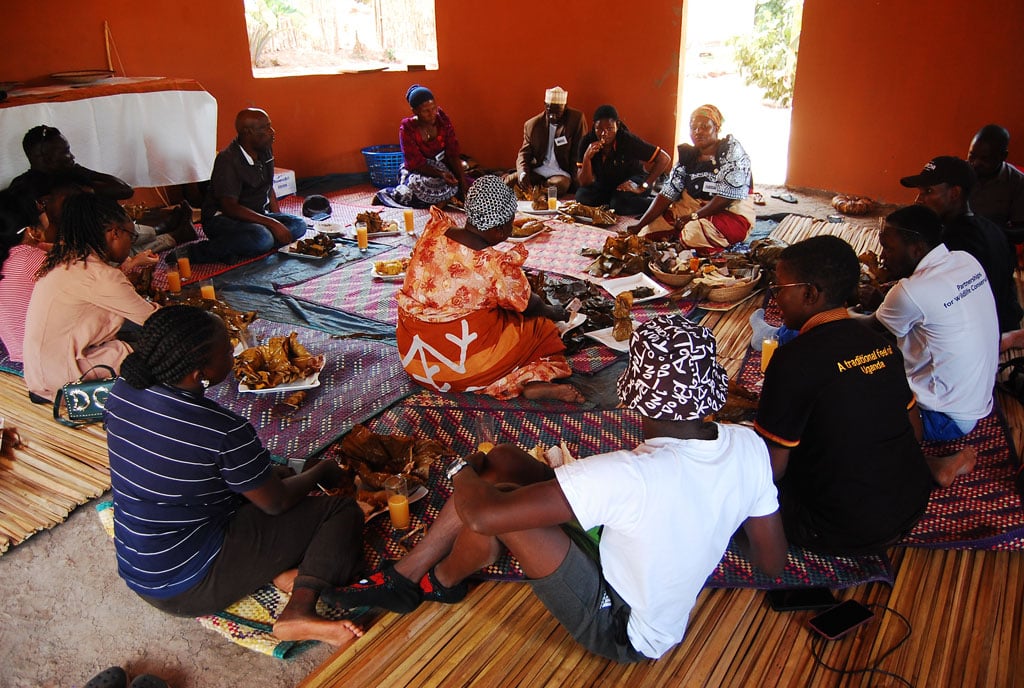Prime
Culture is rutan: Where Baganda learn their ways

Some of the visitors fetching water from the well. PHOTO/JONATHAN KAMOGA
What you need to know:
- The centre has guides for nearly each activity that it offers.
At Ewaffe (Luganda for our home), located in Naggalama village in Mukono district, about 40km east of Kampala, a cultural village offers a glimpse on the ways of life of a traditional Baganda household in the past days.
Some of these have died out while others are still being practised in rural Buganda.
The centre presents a visitor with a feel of Buganda’s cultural norms and traditions through food, farm tours, cookery, pottery, and storytelling.
A visitor is welcomed with sounds of drums, folk songs and dances by a small group of elderly and young folk.
A lonely grass-thatched hut with wide front and back entrances stands in the middle of the yard, with several small gardens separated by narrow paths. Each garden is planted with a different crop; from herbs to food crops and trees.
Each crop served a purpose in the old days.
The visitors are served sugar cane and fruits, including watermelon, bananas, pineapples, berries and mangoes.
These are then washed down with either pot water or banana juice locally made by squeezing yellow bananas in a trough using spear grass.
Next is a medicinal trail, a tour that takes one to see the different herbs that the traditional Buganda household held — aloe vera, lemon grass, okra, mint.
The trail continues to fishing ponds. Although long ago fishing was carried out on lakes and rivers using nets, spears and wooden canoes, the ponds here give the activity fun in that a visitor catches the fish he or she will have for lunch.
There is a pond where the girls draw water using pots, which they carry on their heads back “home.”
Visitors are taken through the process of making barkcloth from the Mutuba tree (ficus natalensis) by beating it with a club and drying it.
In the old days, craftsmen were tasked to make bark cloth for the Baganda royal family and the rest for the community.It was used as clothing, bedsheets, mats, and given as gifts. The barkcloth was also used as a burial shroud.
The production of barkcloth was widespread, with workshops in almost every village in the Buganda Kingdom. With the introduction of cotton cloth by Arab caravan traders in the 19th century, production slowed and eventually faded out, limiting the use of barkcloth to cultural and spiritual functions.
The centre has guides for nearly each activity that it offers.
Middle-aged women take visitors through food preparation such as peeling matooke, wrapping them in raw banana leaves, tying the heap together and steaming them before using the same banana leaves to squeeze them into dough.
Visitors are also taken through the process of making Luwombo, a local recipe made from wrapping either spiced meat or chicken in green banana leaves and then steaming it.
It is chicken luwombo that is served together with several traditional foods like sweet potatoes, matooke, cassava, pumpkins.
The day ends with sex education by a kojja (uncle) for the boys and a senga (aunt) for the girls.
The place
Ewaffe Cultural village presents to you a feel of Uganda’s unique cultural norms and traditions. A visitor experiences utmost fun through food tourism, farm tours, cooking courses, pottery, storytelling through the unique norms relating more to the Buganda Culture as one of the most vibrant tribes of Uganda.





